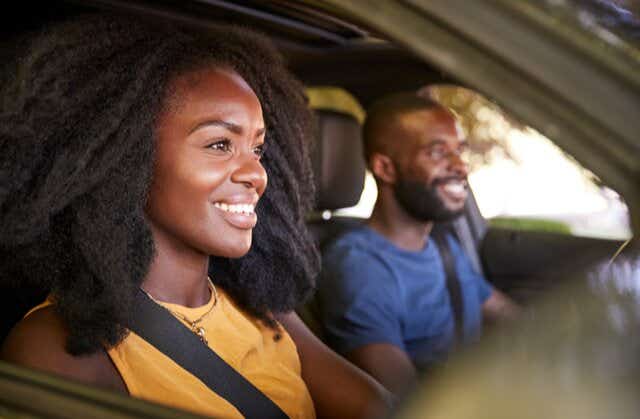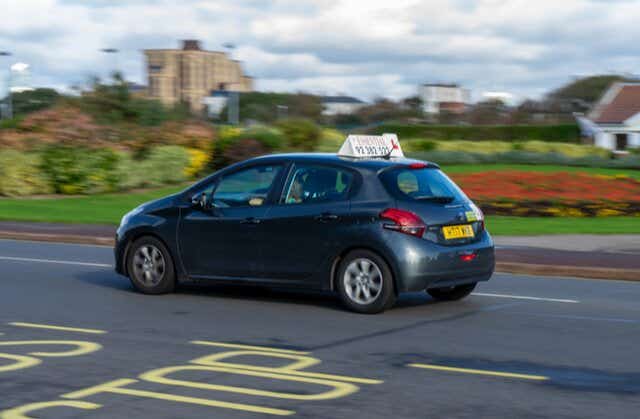How much does it cost to learn to drive?
Provisional licence, driving lessons, the driving theory test and then the driving test — and that’s all before you factor in the cost of your first car, and the cost of car insurance.
Learning to drive a car in the UK isn’t cheap, in fact the average cost can run into the thousands.
However, there are ways to save some much needed money, if you prepare and plan enough. Here’s an idea of how the cost of driving lessons breaks down, as well as the other elements you should consider when thinking about driving.
Get a car insurance quote
See a range of car insurance quotes in just a few minutes when you compare with Uswitch
Preparing for your first car - what do you need?
The cost of a provisional driving licence
Learner drivers can apply for a provisional licence three months before their 16th birthday, but remember you can't get behind the wheel until you're 17. You will need this before you can start taking lessons, even if it's with friends or family.
Provisional licence cost varies from £34 for online applications, to £43 for postal applications.
The GOV.UK website have outlined three things may need to confirm your eligibility for your first provisional driving licence you will be asked:
your UK passport number
your National Insurance number if you know it
you may also have to provide addresses where you've lived over the last 3 years
Personal Independence Payment (PIP)
Personal Independence Payment benefit given in the UK to help adults living with a long-term health condition or a disability. If you’re receiving PIP, you can learn to drive a car and take a test when you’re 16 if you get, or have applied for, the mobility part of PIP.

Driving lessons cost - how many lessons do you need?
There's no set amount of lessons you must take before taking your driving test. You and the person supervising or your driving instructor, should come to an agreement when you're ready for your test.
For this reason, there's no way of knowing exactly how many lessons you'll need, before you'll take your test. What you will know in advance, is the cost of driving lessons.
How much are driving lessons?
According to the RAC, the average driving lesson costs can vary between £25 and £30. But it's important to note that driving instructors can charge what they like. So this fee can change depending on who you choose and the part of the UK that you are learning.
Block booking lessons - can this save you money?
Some people will choose to block book their lessons as this can offer a slight discount in the amount you will pay. The amount per school or individual will vary.
According to the Driver and Vehicle Standards Agency (DVSA), the average learner driver takes up to 47 lessons before they pass their test. You will either pay your instructor per lesson, or for a set amount of lessons each time, say a block book of 10.
For those who have the time or the money available, they may choose to opt for an intensive course. This is where you spend a week or two weeks focused on learning to drive, usually with a test at the end of the course.
This type of course might be more suited to someone who is already familiar with driving, and not taking lessons for the first time. The pressure of having to complete a test at the end of the course, might not be suited to someone who is new to the roads and wants to learn at their own pace.

What is the cost of an intensive driving course?
Intensive driving courses, also called crash driving courses, are popular with learner drivers who don’t want to spend months, or years learning to drive.
Some intensive driving courses can help learner drivers pass their test in two weeks
You must normally have passed the theory part of the driving test
You can do it in one or two weeks, and expect to spend between 4 and 5 hours a day on the road
If you have already taken a few lessons you might opt for a two-day course with just 10 hours of training.
It’s not cheap, a week-long course can cost around £1,000, while a two-week course may be double that.
However it could save you money in the long run. If the average person takes 47 lessons to learn to drive, then your driving lessons will cost at least £1,000 and remember you have to budget for the cost of theory and practical tests on top of that.
How to get cheap driving lessons
Block-booking or having two-hour lessons can often get you discounts, though make sure you’re comfortable with the driving instructor before committing
Make sure you compare driving lesson prices to make sure you're getting a good deal
Intensive driving courses — where you learn to drive in under a week or two — can work out cheaper - these courses can involve up to six hours driving a day. So it’s worth discussing with a course advisor before signing up
Comparing the cost of UK driving lessons
These are the main driving schools operating in the UK. You will need to check whether they operate locally and whether they have any introductory offers.
BSM driving lessons
This is probably the best-known driving school and celebrated its 100th birthday in 2010. It was bought by The AA (The Automobile Association) in 2011, a year later. As well as driving lessons BSM offers advanced driving courses and trains instructors themselves.
How much do BSM driving lessons cost?
The price of lessons differs across the country with prices starting from £22 per hour.
BSM says, learner drivers can take advantage of a discount by having driving lessons with a trainee instructor. All trainee instructors have undergone theory and practical training and are gaining experience to increase their instructional skills prior to becoming fully qualified.
Red Driving school
Red Driving School, which currently offers 50% off the first lesson, also operates across the UK. It also offers advanced driving and instructor driving courses. It has a partnership with the RAC, and offers cheaper driving lessons to friends and family of RAC members.
How much do Red Driving School lessons cost?
Red Driving School offers lessons from £19 per hour.
Red offers block booking discounts of up to 12% on 30 hours of lessons, other discounts include a free hour introductory discount when you book your first two hours of lessons, or six introductory lessons for the price of four.
AA Driving School
Although The AA owns BSM, the AA still has a separate driving school, which offers lessons around the UK. Members can get discounts on the price of lessons, if they block book.

How much do AA Driving School lessons cost?
AA Driving School lessons are priced from £24 depending on where you live.
The AA offers a discount of £6 off per hour off the first six hours of lessons when you make a block booking.
AA Members only, can get £2 off per hour off block bookings after their first block booking
The cost of learning to drive - how much does a driving theory test cost?
The price of taking the driving theory test – which examines your knowledge of essential driving skills, traffic signs, and The Highway Code – costs a flat £23 for cars and motorbikes.
You need to book and pass your driving theory test before you’re able to take your practical driving test.
The cost of learning to drive - how much is a practical driving test?
Driving tests cost £62 on weekdays, and £75 for on evenings, weekends and Bank Holidays
If you intend to use your driving instructor’s car you’ll need to book their time as well as the test.
Many people choose to practise for an hour before the test, which can quickly increase the cost.
Most drivers pass on their second attempt, so budget for having to take the test twice.
What is the total cost of learning to drive?
Depending on how many lessons you need, Hitachi Personal Finance estimated the average learner spends at least £1,676 before they can legally get behind the wheel. This includes the cost of insurance, provisional licence and the theory test.
This does not include the cost of buying a car.
If you have to use the instructor’s car for practising and you need to take your test multiple times, you could find yourself spending well over £3,000 to pass your test.
The cost of learning to drive - learner driver car insurance
After passing the test, car insurance is by far the biggest cost for young drivers to contend with.
Average comprehensive premiums for young drivers aged under 25 are £1,544, compared to an average of £395 for drivers over 50.
This data, compiled by the Consumer Intelligence Price Index, found the cost rose dramatically in risky areas and for higher performance vehicles.
How can I save on provisional driver’s insurance?
The best way to achieve long-term savings on your car insurance is to take out your learner driver insurance, while you're still driving on a provisional licence.
you will be able to start building your no-claims bonus even before you have passed your driving test
once you start building your no-claims bonus your premium should drop steadily each year as long as you don’t make any claims
taking out an insurance policy in your own name means you will also avoid the risk of damaging your friend’s or relative’s no-claims bonus as you might if you had to make a claim as a named driver on their policy.
if you take out your own insurance policy, there should be no effect on the main driver’s insurance premium.
The cost of learning to drive: how to save on insurance
If you're looking for learner driver insurance for your own car and need a provisional driver insurance quote, there are a couple of issues to consider.
What kind of car you drive
The type of car you drive will often have an impact on the amount you pay for insurance – but with provisional driver’s insurance, most policies will cover you for any car up to a certain value or insurance group (usually a value of £20,000 or around insurance group 30).
This is great if you want to learn in your parents’ car, and then you can choose a cheaper car to insure once you’ve passed your test.
When buying a first car, the type of car you choose will have a big impact on how much you’ll pay for insurance — see our guide to the ten cheapest cars to insure for more.
Always shop around
By shopping around it's possible to get driver cover for the equivalent of a couple of pounds per day. The driver insurance is one that offers good value and sufficient cover for your needs, without too large an excess.
The type of car you drive
Having a car is the type of car you drive, with the car’s speed, security features, and value all playing a big part – read our guide to the cheapest cars to find out which cars attract the cheapest insurance premiums.
Increase your voluntary excess
This will result in a cheaper monthly premium. Before you take out car insurance make sure you can afford any voluntary excess. This excess is in addition to the compulsory excess set by your insurance provider. This is what you would have to pay if you ever have to claim.
Pay upfront
Pay for your insurance in one go if you can. Spreading the cost of your car insurance over 12 payments, monthly, may seem cheaper, but remember you will be paying interest on top of the amount you pay towards your car insurance premium.
Drive less
Limiting your miles makes you less of an insurance risk. Simply because you are reducing your risk of having an accident. When you take out your car insurance policy the insurer always asks for an estimate of your maximum annual mileage.
You need to try and keep your mileage low, although you need to be realistic as to how much you will drive. Extra security
Having an alarm or immobiliser is considered a theft deterrent and by deterring car thieves you can reduce your car insurance. Not all insurers will offer this, so check first.
Consider black box or telematics insurance
Black box, or telematics insurance can help reduce your car insurance over a period of time.
It’s considered a good idea for younger drivers, as it can help cut the cost of premiums.
A small device, the black box, is installed in your car.
this then measures how fast you drive, when you brake, what time of day you drive, how quickly you accelerate and how you drive around corners
some black boxes include an app which you can access on your phone
if you drive safely you may be rewarded with cheaper monthly premiums or more miles of available cover
The cost of learning to drive: save by not owning a car
If you're only planning on borrowing a car, you can also compare quotes for short-term or temporary car insurance
If you're needing to insure several cars, search for multi-car insurance policies.
Multi insurance might also be suitable:
if you own more than one car
if you’re a family with more than one driver
if you’re a couple with more than one vehicle
Get a car insurance quote
See a range of car insurance quotes in just a few minutes when you compare with Uswitch

